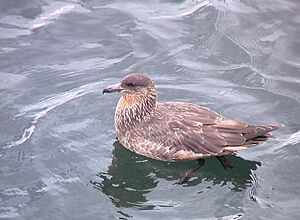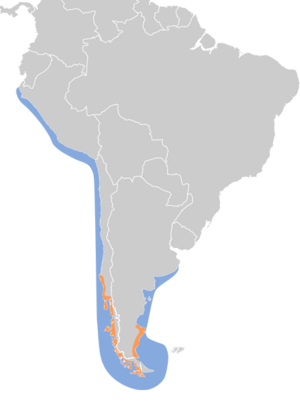Chilean skua facts for kids
Quick facts for kids Chilean skua |
|
|---|---|
 |
|
| Conservation status | |
| Scientific classification | |
| Genus: |
Stercorarius
|
| Species: |
chilensis
|
 |
|
| Synonyms | |
|
Catharacta chilensis |
|
The Chilean skua (Stercorarius chilensis) is a large seabird. It's also known as the cinnamon skua. These birds live in Argentina and Chile. When it's not breeding season, they fly north to places like Brazil and Peru.
It's easy to spot a Chilean skua! They have a dark cap on their head. This dark cap stands out against their cinnamon-colored throat and lower face. Sometimes, Chilean skuas mix with Falkland skuas in southern Argentina.
Chilean skuas eat fish and other seabirds. They also scavenge for scraps and dead animals. They gather in large groups to breed during the Southern Hemisphere summer. Not much is known about this interesting bird. Most of what we know comes from studies at a few breeding spots.
Contents
About the Chilean Skua
The Chilean skua belongs to a big group of seabirds called Charadriiformes. This group includes gulls, terns, and other skuas. It is part of the Stercorariidae family. This family includes all skuas.
Scientists used to put the Chilean skua in a different group called Catharacta. Now, all skuas are in the larger Stercorarius group. Sometimes, Chilean skuas and Falkland skuas have hybrid babies. This happens where their breeding areas meet.
What Does a Chilean Skua Look Like?
Chilean skuas are usually dark on their back, sides, and cheeks. Their underside is light in color. A dark band often goes across their upper chest. The underside of their wings is a special cinnamon color. This color can be lighter on some birds.
Adult skuas have a clear dark cap on their head. They also have light gold streaks on their face and neck. Their legs are black, and their eyes are brown. They have a small, bluish bill with a dark tip. Their wingspan can be up to 138 centimeters wide.
Young Skua Birds
Young Chilean skuas, called juveniles, are often brighter than adults. They don't have the light streaks that adults do. They also have a strong dark cap. However, they often don't have the dark chest band seen in older birds.
You might confuse a Chilean skua with a Falkland skua. But the Chilean skua looks thinner and more compact when it flies. It also has special red colors and white crescent shapes on its wings.
Where Do Chilean Skuas Live?
The Chilean skua lives only in South America. It can be found along the coasts from central Peru to northern Argentina. They build their nests between southern Chile and Cape Horn, Argentina. In winter, they fly north to Brazil. There, they enjoy the warm coastal waters.
In 2009, one Chilean skua was seen far away on Inaccessible Island. This island is in the southern Atlantic Ocean, near Africa.
Favorite Places to Live
Breeding adult skuas like sandy coastlines. They prefer areas with kelp washed up on the beach. They also like places with freshwater streams nearby. These birds are also known to be near southern hake fishing boats. This happens in the fjords and channels of southern Chile.
How Chilean Skuas Behave
Skua Sounds
We don't know much about the sounds Chilean skuas make. At their breeding colonies, they have a "long-call." This call is ten to twelve short, nasal barks. It sounds deep and hoarse, almost like a goose. This call doesn't seem to be for raising chicks. They might also make short, guttural grunts.
What Skuas Eat
The diet of the Chilean skua is not fully known. But they seem to be opportunistic scavengers. This means they eat whatever they can find. They have been seen eating dead penguins, fish, and food from dumpsters. They are also known to steal fish from other seabirds.
They hunt and eat other birds like imperial cormorants and sooty shearwaters. They also eat the eggs and chicks of black-browed albatross and grey-headed albatross. Sometimes, they eat white-chinned petrels, Magellanic diving petrels, cormorants, geese, and even small mammals like nutria. They also eat crustaceans and barnacles.
Skua Families and Babies
From November to March, Chilean skuas gather in breeding colonies. These colonies are in sandy coastal areas. Breeding adults usually stay in the middle of the colony. Younger birds and non-breeding adults stay on the edges.
When someone gets too close to their nest, parents will attack from above. They might even drop waste on the threat. If another skua is the intruder, it might pretend to have a leg injury. This shows it is giving up to the attacking bird. Skuas only fight with their neighbors in colonies that are not very crowded.
Female skuas usually lay two eggs. The eggs are incubated (kept warm) for 28 to 32 days.
Skua Chicks
When their parents are away, skua chicks stay still at their nest. They use the sand and patches of giant kelp to hide. When their parents are nearby, they might explore a bit. But if they sense danger, they quickly walk back to the nest. They fold their wings and tuck their head under their shoulders to hide.


